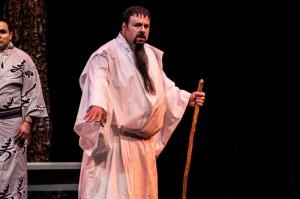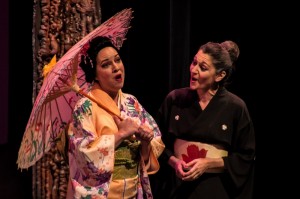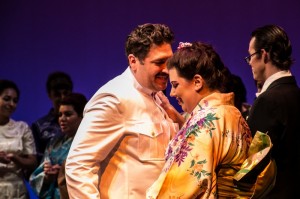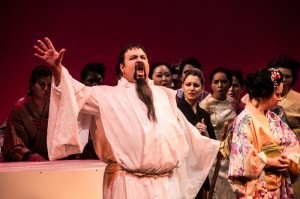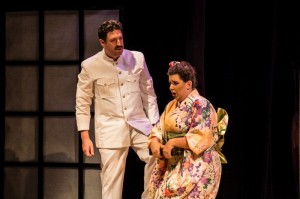A BUTTERFLY WITHOUT WINGS
Madama Butterfly (1904) is understandably one of the most popular operas in the world. Not only does it boast a tragic story that is incredibly moving, but the drama at its core is heightened and given beauty by Giacomo Puccini’s score. However, Center Stage Opera’s production fails to do the opera justice. It comes across as somewhat bland and lackluster, despite a number of excellent singers.
Despite limited resources, the company could have done more and better. Much of the blame must lie with director Dylan F. Thomas. First, he opts for a minimal set in order to “emphasize Cio-Cio San’s isolation,” as he writes in the program notes. On stage, this means that her house has no walls, just a raised floor with steps leading up to it and a single sliding wall panel for color. In other words, the house is an abstraction that fails to confine her. From the audience’s perspective, it is actually open and spacious. Moreover, the lack of realism in the design of the set does not extend to the costumes, leaving the production’s aesthetic jarringly uneven.
In addition to the set’s minimalism, there is a lack of proportion. The house is simply too big. Because it takes up more than half of the stage, there is very little room for the crowds of people that come to witness Cio-Cio San’s marriage to Pinkerton. Thus, they are bunched up to one side of the house instead of spreading out across the wide expanse of the stage. This has the unhappy effect of limiting movement, contributing to a rather static performance. Even when there are fewer characters on stage, movement is minimal.
Although Puccini’s opera is set in the late nineteenth century, Thomas has moved the story forward in time to the late 1950s. Pinkerton is now a sailor in the U.S. Navy who marries a local Japanese girl, a familiar enough scenario in the post-war era. This transposition of the story, however, adds nothing to our understanding of Madama Butterfly, but actually domesticates much of what must have made the story incredibly exotic to its original Italian audience. It also makes anachronistic the opening dialogue between Pinkerton and Goro in which they talk about Cio-Cio San as if she were a piece of property.
The opening night’s two leads, Matthew Miles as Pinkerton and Adrien Roberts as Cio-Cio San, performed their parts well, albeit without chemistry. Apart from Miles’ soaring tenor, it’s difficult to fathom why Cio-Cio San falls in love with the cocky American sailor. There’s something stubborn and willful, as well as naïve, about her love, but Roberts endows her with enough nobility in the second and third acts for the audience to be quite sympathetic to her plight. The lovers’ long duet at the end of the first act is one of the most enchanting moments of the whole performance.
Also noteworthy are Jamie Samantha Lee as Suzuki and Babatunde Akinboboye as Sharpless. Lee’s understated performance belies her voice’s beautiful tone, which could have been more prominent. As the consul, Akinboboye brings gravitas and authority to his rule, in contrast to Carl King’s caricature of the Bonze.
Madama Butterfly brings to an end Center Stage Opera’s ninth season. Coming up next season are Verdi’s La Traviata and Bizet’s Carmen. While both are undoubtedly gorgeous works, it is disappointing that CSO has chosen two operas that have already been performed quite successfully in LA and Orange County earlier this year.
photos by Kathy Flynn
Madama Butterfly
Center Stage Opera
Madrid Theatre
21622 Sherman Way in Canoga Park
played June 7 and 8, 2014
for more info, visit Center Stage

